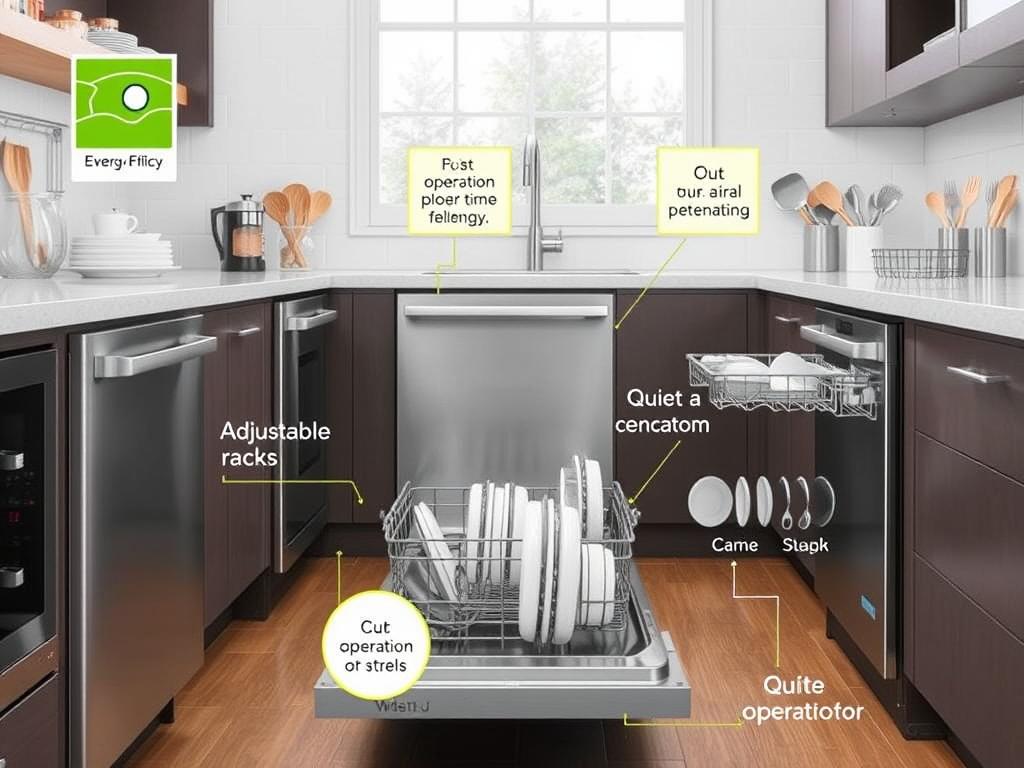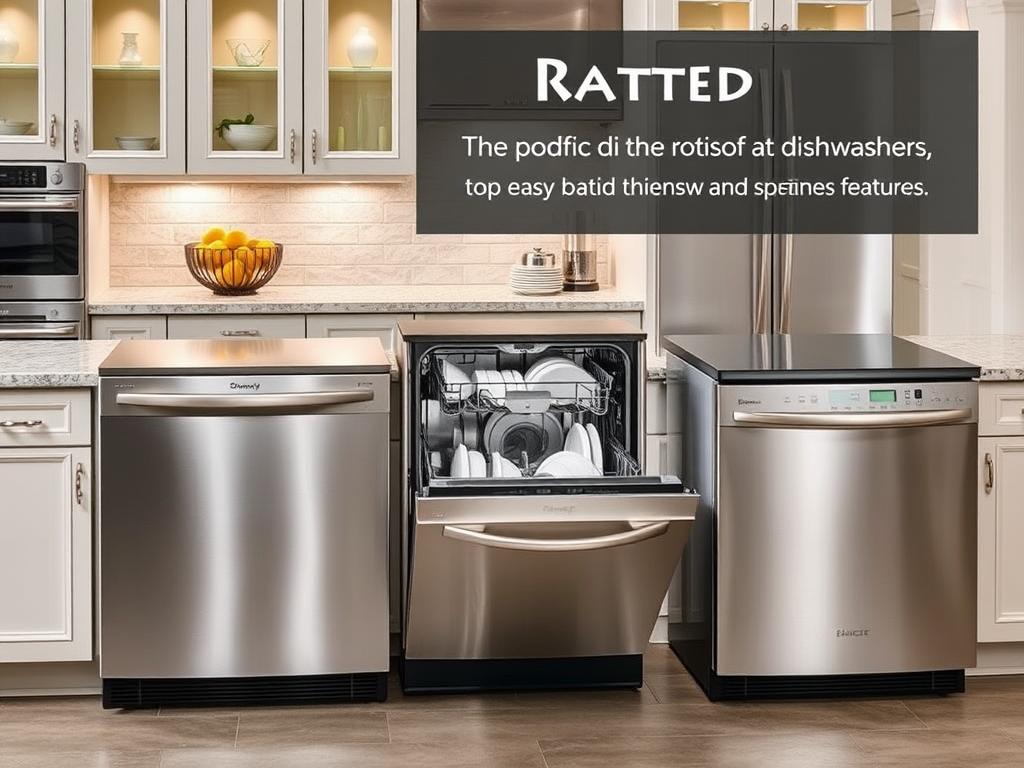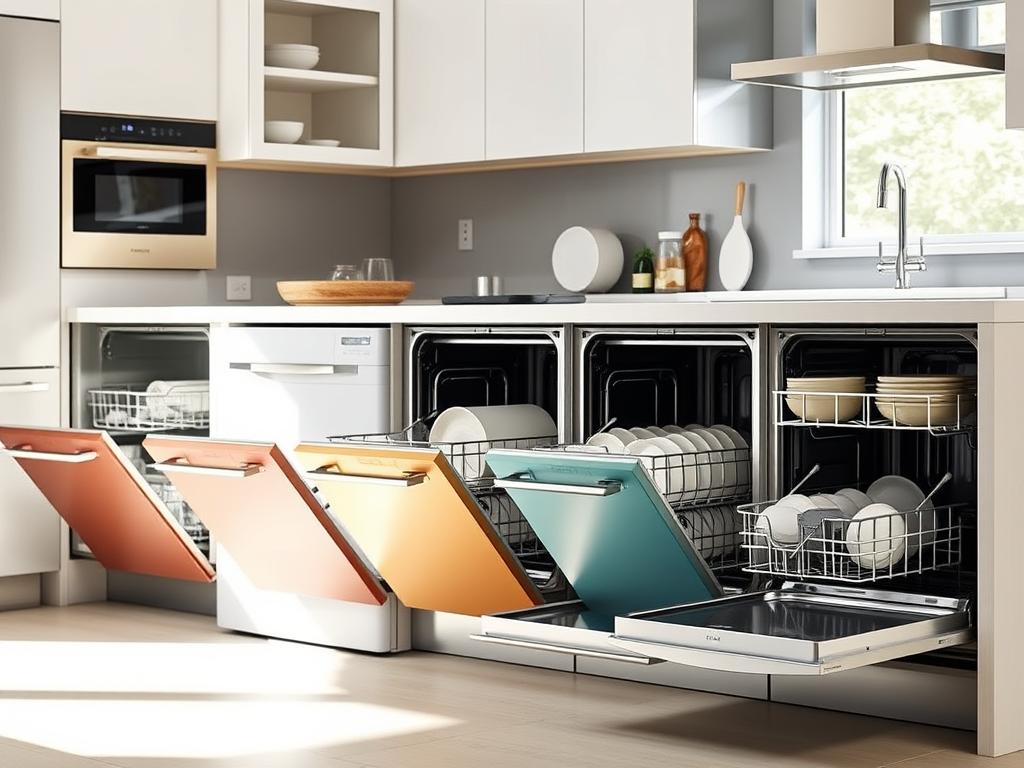Imagine finishing a delightful dinner with friends or family and basking in the joy of connection, only to be met with the daunting task of washing up. For many of us, this moment can feel overwhelming. In our daily lives, we crave efficiency and ease, and this is where the right dishwasher becomes essential. Knowing how to select the best dishwasher for home use is more than just shopping; it’s about enhancing your lifestyle, relieving stress, and maximizing precious time spent with loved ones.
A thoughtful dishwasher buying guide goes beyond the kitchen space — it considers family size, your unique lifestyle, and specific needs. Let’s delve into how the right choice can transform your post-meal experience, ensuring that your home remains a sanctuary of comfort and connection.
Key Takeaways
- Choose a dishwasher that fits your kitchen space and meets your family’s needs.
- Evaluate energy efficiency ratings, particularly the new A to G scale.
- Consider noise levels; quieter models enhance your home’s ambiance.
- Look for wash cycle options tailored to your dishwashing requirements.
- Understand capacity and size to ensure it accommodates your average load.
- Explore top brands for reliability and performance in dishwashers.
- Plan your budget, including initial costs and long-term operating expenses.
Understanding Dishwasher Types
When selecting a dishwasher, understanding the various dishwasher types will help you make an informed choice. Each type has distinct characteristics that cater to different needs, space constraints, and preferences.
Built-in vs. Portable
Built-in dishwashers are the most common choice for many homes. They blend seamlessly into your kitchen and are permanently installed. Built-in models generally offer higher capacities, reliable performance, and a variety of features suited for larger households. In contrast, portable dishwashers provide the flexibility of mobility, making them ideal for apartments or homes without a dedicated installation space. These typically connect to the kitchen faucet and can be easily stored when not in use.
Compact vs. Standard Size
For those with limited kitchen space, compact dishwashers are perfect. Measuring around 18 inches wide, they fit snugly into smaller areas while still providing efficient dishwashing. Standard-size dishwashers, usually around 24 inches wide, cater to larger families and provide ample washing capacity. Knowing the available space in your home is crucial when deciding between these dimensions.
Specialty Dishwashers
Specialty dishwashers meet unique requirements such as energy efficiency, compact spaces, or specialized functionalities. Options include dish drawers and smart technology models that offer WiFi connectivity for remote access. These dishwashers often emphasize convenience, making them suitable for specific lifestyles. For example, some models equipped with self-cleaning functions can handle food scraps effectively, enhancing overall convenience.
Understanding the different dishwasher types helps in making a decision that aligns with your needs while ensuring a harmonious blend with your kitchen environment. For more insights on owning pets, consider exploring which pet birds might be best for.
Key Features to Consider
When selecting a dishwasher, numerous features can significantly influence both functionality and efficiency. Paying attention to energy efficiency ratings is essential, as energy-efficient dishwashers can offer substantial savings over time. Models with the ENERGY STAR certification can reduce energy consumption by 25% or more, making them an excellent choice for eco-conscious consumers.
Energy Efficiency Ratings
Understanding energy efficiency ratings can lead to lower utility bills. Dishwashers generally use just over one kWh per cycle, demonstrating remarkable efficiency compared to washing by hand. The average operating cost for running a dishwasher on its default cycle is approximately $159 a year, including electricity and water. This highlights why investing in an energy-efficient dishwasher not only contributes to a greener environment but also reduces long-term expenses.
Noise Levels and Performance
Another critical factor is dishwasher noise levels, which can vary immensely between models. Ranging from a quiet 38 dB to a more noticeable 60 dB, it’s wise to choose a model that aligns with your household’s noise tolerance. Generally, dishwashers with stainless steel interiors provide better sound insulation, making them ideal for open-plan living spaces. Aiming for a noise level between 40 and 50 dB can ensure a pleasant kitchen environment.
Wash Cycle Options
Different wash cycle options can enhance cleaning performance based on your needs. Common cycles include Normal, Heavy, Quick Wash, and specialized settings for delicate items or pots and pans. Many modern dishwashers offer features like soil sensors that adjust wash intensity based on the level of dirt, ensuring optimal cleaning with every load. Adjustable racks further maximize space and accommodate various dish sizes, adding to the versatility of any dishwasher.

Capacity and Size
Choosing the right dishwasher size and capacity for your kitchen is essential for both functionality and aesthetics. When starting the selection process, an important aspect involves measuring dishwasher space. Accurate measurements ensure that the new appliance fits seamlessly within existing cabinetry while providing the necessary capacity for your household needs.
Measuring Your Space
Begin by measuring the designated area in your kitchen. Standard built-in dishwasher dimensions typically sit at approximately 24 inches wide, 24 inches deep, and 35 inches high. For those with compact living arrangements, options exist in smaller sizes, with compact dishwashers averaging around 18 inches wide. When selecting a portable model, dimensions generally vary, typically measuring 24 inches in width and 27 inches in depth.
Determining Load Capacity
Understanding load capacity is crucial when evaluating your dishwasher options. Standard-sized dishwashers typically accommodate between 10 to 12 place settings, making them suitable for average-sized families. If there are more people in the household, considering models like KitchenAid® that feature a third rack can provide additional room, allowing for up to 16 place settings. This expansion not only enhances cleaning capabilities but also improves organization within the machine.
Family Size Considerations
Family size considerations greatly influence the choice of dishwasher. A family of four will require a larger capacity than a single-person household. Evaluating how often you entertain guests and the types of dishes used can further guide your decision. When mapping out the best fit for your kitchen, pay attention to the configuration of racks to ensure compatibility with larger dish items like serving platters. Maximizing efficient use of space translates to smoother operations and less time spent on cleanup.
| Dishwasher Type | Width (inches) | Depth (inches) | Height (inches) | Place Settings |
|---|---|---|---|---|
| Standard Built-In | 24 | 24 | 35 | 10-12 |
| Oversized Built-In | 30-42 | 24 | 35 | Varies |
| Compact Built-In | 17⅝ – 18 | 24 | 35 | 8-10 |
| Portable | 18-24 | 26-30 | 36-37 | Varies |

Top Brands and Models
Choosing a dishwasher involves understanding the leading brands and their standout models. Several manufacturers have earned top ratings among consumers for reliability and performance. This section explores popular brands, high-end choices, and budget-friendly alternatives available in the market.
Popular Brands Overview
Brands such as Miele, Bosch, and LG consistently receive praise in consumer surveys for their innovation and customer satisfaction. Miele, in particular, garners the highest owner satisfaction ratings in the industry. In a 2023 survey of nearly 1,500 homeowners, reliability data highlighted these brands as reliable choices for homeowners seeking top-rated dishwashers.
Best High-End Models
For those seeking the best high-end dishwashers, models like the Miele G5008 and Bosch Benchmark Series stand out. The Miele G5008, priced at $1,849, fits 16 full place settings and operates at a whisper-quiet 43 dBA. Its efficient design leads to an estimated yearly energy cost of just $32. Bosch’s Benchmark Dishwasher, which retails for $1,800, operates even quieter at 38 dBA, making it an excellent choice for luxury kitchens.
Budget-Friendly Alternatives
For consumers focused on affordability, options like the LG Front Control Dishwasher provide exceptional performance without breaking the bank. Priced around $450, it offers a noise level of 52 dBA and an estimated annual energy cost of $33. The GE Profile UltraFresh Dishwasher, available for $850, features a noise rating of 42 dBA and offers reliable performance for budget-conscious households.

Installation and Maintenance
Installing and maintaining your dishwasher properly can significantly extend its lifespan and enhance performance. A few helpful dishwasher installation tips can assist both DIY enthusiasts and those considering professional installation. Understanding the differences in installation options will make the process smoother and more efficient.
DIY Installation Tips
For those opting for DIY installation, taking the right measurements and checking water connections is crucial. Here are some essential tips:
- Measure the space where the dishwasher will be placed to ensure a snug fit.
- Ensure all plumbing connections are secure and properly aligned.
- Use a level to ensure the dishwasher is installed evenly for optimal performance.
- Consult the installation manual to follow specific manufacturer instructions.
Professional Installation vs. DIY
While DIY installation may be tempting, consider the complexity of your specific model. Professional installation often guarantees secure fittings and correct connections, especially for built-in or integrated dishwashers. This service can prevent potential issues such as leaks or inefficient operation. Weigh the cost of hiring a professional against the potential for problems down the line when deciding on DIY installation.
Regular Maintenance Tips
Routine upkeep is key to maximizing your dishwasher’s efficiency. Incorporating these maintenance tips for dishwashers can help prevent minor issues from escalating:
- Clean the dishwasher filter regularly to avoid clogs and ensure optimal cleaning.
- Inspect water hoses for damages or wear, replacing them when necessary.
- Run a cycle with vinegar or a dishwasher cleaner monthly to eliminate odors and buildup.
- Check the spray arm for blockages to guarantee even water distribution during cycles.
By following these dishwasher installation tips and maintenance recommendations, you’ll enjoy a more efficient appliance and a cleaner kitchen.
Cost and Budget Planning
When considering a dishwasher for your home, it is crucial to pay attention to both the initial purchase price and long-term costs. Various factors affect the overall expense, from the type of dishwasher to its features. Understanding these elements can significantly aid in effective dishwasher cost planning.
Initial Purchase Price
The initial purchase price of a dishwasher can vary extensively. Basic models typically start around $300, while high-end versions may reach prices upwards of $3,000. If you opt for additional features like stainless steel interiors or advanced washing cycles, expect to pay on the higher end of the range. Compact options for smaller kitchens generally cost between $400 and $1,500.
Long-Term Operating Costs
Long-term dishwasher costs include factors such as water usage and energy consumption. Generally, dishwashers consume about 4 to 6 gallons of water per cycle, which is significantly less than hand-washing dishes. ENERGY STAR-rated models use as little as 3.5 gallons, which can lead to notable savings on water bills. Furthermore, efficient dishwashers typically use less energy, allowing you to save substantially over time.
Financing Options
Financing a dishwasher purchase can make it easier to afford your desired appliance without straining your budget. Many retailers offer flexible payment plans or special promotions that allow you to spread out the cost. Look for financing options that fit your financial situation best, ensuring that your investment aligns with both your immediate and future budgetary goals.
| Dishwasher Type | Price Range | Water Usage (per cycle) | Energy Efficiency |
|---|---|---|---|
| Basic Model | $300 – $700 | 4 – 6 gallons | Standard |
| Midrange Model | $700 – $1,200 | 4 – 5 gallons | ENERGY STAR |
| High-End Model | $2,500 – $3,000+ | 3.5 – 5 gallons | Advanced Efficiency |
Paying attention to these cost factors and understanding financing opportunities will make it easier to choose a dishwasher that meets your needs, while remaining within your financial means. For further insights on evaluating personal needs in tech purchases, check out this guide on choosing the right.
Final Tips for Your Dishwasher Purchase
As you approach the finish line in your dishwasher shopping journey, it’s crucial to consider a few final tips for buying a dishwasher. Start by reading dishwasher reviews from both customers and trusted experts. These reviews can provide insights into how well different models perform over time and their reliability under various conditions.
Reading Reviews
Gathering information through reading dishwasher reviews helps paint a clearer picture of the units you’re interested in. Look for common themes in user feedback, particularly regarding performance, efficiency, and any potential issues. Remember, personal experiences from others can significantly influence your decision-making for dishwashers.
Consulting Friends and Family
Additionally, don’t hesitate to consult friends or family who have recently made similar purchases. Their insights based on real-life use can be invaluable. Their recommendations might lead you toward models you hadn’t considered, ensuring that your final choice meets both your needs and preferences.
Making the Decision Process Easier
Lastly, simplify your decision-making process by creating a checklist of your must-have features versus nice-to-haves, including capacity, energy efficiency, and noise levels. This organizational tool can help you navigate through numerous options effectively, keeping you within budget and aligned with your preferences. By following these tips, you’ll be well on your way to selecting a dishwasher that truly fits your household’s needs.
For more parenting tips on creating safe spaces for your pets, check out this helpful guide.











